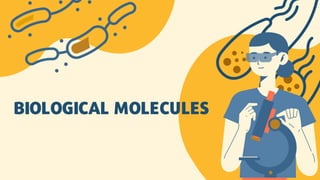Report
Share
Download to read offline

Recommended
More Related Content
Similar to Biological Molecules.pdf
Similar to Biological Molecules.pdf (20)
Concepts in BiochemistryChapter 2Wendy Herndon, BIS, RDH, CD

Concepts in BiochemistryChapter 2Wendy Herndon, BIS, RDH, CD
Protein-Introduction, Classification, Function, Deficiency Symptoms

Protein-Introduction, Classification, Function, Deficiency Symptoms
Structures and Functions of Biological Molecules Grade 11 Biology.pptx

Structures and Functions of Biological Molecules Grade 11 Biology.pptx
Recently uploaded
Recently uploaded (20)
Classification of Kerogen, Perspective on palynofacies in depositional envi...

Classification of Kerogen, Perspective on palynofacies in depositional envi...
Vital Signs of Animals Presentation By Aftab Ahmed Rahimoon

Vital Signs of Animals Presentation By Aftab Ahmed Rahimoon
TransientOffsetin14CAftertheCarringtonEventRecordedbyPolarTreeRings

TransientOffsetin14CAftertheCarringtonEventRecordedbyPolarTreeRings
ANITINUTRITION FACTOR GYLCOSIDES SAPONINS CYANODENS

ANITINUTRITION FACTOR GYLCOSIDES SAPONINS CYANODENS
Micropropagation of Madagascar periwinkle (Catharanthus roseus)

Micropropagation of Madagascar periwinkle (Catharanthus roseus)
An Overview of Active and Passive Targeting Strategies to Improve the Nano-Ca...

An Overview of Active and Passive Targeting Strategies to Improve the Nano-Ca...
Manganese‐RichSandstonesasanIndicatorofAncientOxic LakeWaterConditionsinGale...

Manganese‐RichSandstonesasanIndicatorofAncientOxic LakeWaterConditionsinGale...
Soil and Water Conservation Engineering (SWCE) is a specialized field of stud...

Soil and Water Conservation Engineering (SWCE) is a specialized field of stud...
Fun for mover student's book- English book for teaching.pdf

Fun for mover student's book- English book for teaching.pdf
Biological Molecules.pdf
- 2. INTRODUCTION Majority of the elements that compose the human body are oxygen, carbon and hydrogen. These elements are obtained from a myriad of biogeochemical processes that happen to an individual everyday. Looking at a close picture of the mentioned elements, we see that different molecules found within the cells fuel, not only humans but all living things.
- 3. BIOLOGICAL MOLECULES PROTEINS CARBOHYDRATES LIPIDS NUCLEIC ACID
- 4. PROTEIN most abundant organic compound amino acids essential in the cell structure gene activators, membrane receptors, clotting factors and many more maintains fluid balance in the body; acid-base aids in the replication, transcription and translation of DNA
- 5. essential amino acids: obtained through consumption of foods rich in protein; example of essential amino acids are: isoleucine, leucine, lycine, methionine, phenylalanine, threonine, tryptophan and valine non-essential amino acids: produced by the body, examples are alanine, arginine, asparagine, aspartic acid, cysteine, glutamic acid, glutamine, glycine, histidine, proline, serine and tyrosine. PROTEIN
- 6. CARBOHYDRATES C (H O) the most abundant biochemical in the world composed of carbon, hydrogen and oxygen effective energy-yielding nutrients and building materials n n 2
- 7. TYPES OF CARBOHYDRATES MONOSACCHARIDES DISACCHARIDES POLYSACCHARIDES Glucose Fructose Galactose Sucrose Lactose Maltose Cellulose Chitin Starch Glycogen
- 8. Monosaccharides simplest form of sugar (1 sugar unit) C H O 6 12 6 Fructose found in fruits, honey and corn syrups Glucose the only sugar used by the body that provides energy; abundant in the blood Galactose important component that serves marker to identify blood types
- 9. Sucrose table sugar (glucose + fructose) Disaccharides simplest form of sugar (1 sugar unit) C H O 22 12 11 Lactose milk and milk products (glucose + galactose) Maltose found in beers
- 10. Cellulose cell walls of plants and bacteria Polyccharides components of the structural parts of living things and storage of energy Chitin exoskeletons of animals Starch a stored energy from potatoes, wheat, bread, pasta Glycogen animal starch stored in liver and muscle
- 11. LIPIDS are largely nonpolar and hydrophobic class of carbon-containing compounds Fats - composed of 1 glycerol and three fatty acids (triglycerides) Steroids - cholesterol, sex and adrenocorticoid hormones and ergosterol Phospholipids - present in the cell wall/membrane Types of Lipids - deposited in adipose tissues and as source of energy - serves as cushion to internal organs - serves as insulators
- 12. NUCLEIC ACIDS made up of nucleotide store information that is used by cells to maintain, repair and reproduce cells. there are two kinds of nucleic acids: DNA and RNA
- 13. James Watson and Francis Crick in 1953 2 helical strands carries instructions that control the activities of the cell carrying the genetic information DNA Deoxyribonucleic Acid
- 14. James Watson and Francis Crick in 1953 2 helical strands carries instructions that control the activities of the cell carrying the genetic information DNA Deoxyribonucleic Acid
- 15. uses the instructions from DNA to make proteins named after the ribose sugar found in the molecules backbone RNA Ribonucleic Acid
- 16. Messenger RNA (mRNA) - transmit genetic instructions coded in the DNA inside the nucleus to the cytoplasm particularly in the ribosome where it is translated into amino acids to produce proteins Transfer RNA (tRNA) - found in the cytoplasm of the cell and translates the code of mRNA into amino acids by attaching amino acis to the ribosomes facilitating protein synthesis. RNA Ribonucleic Acid
- 17. Ribosomal RNA (rRNA) - the protein factory of the cell and are abundant in the cytoplasm RNA Ribonucleic Acid
- 18. REFERENCES GENERAL BIOLOGY BY LORIMAR PUBLISHING CONCEPTUAL SCIENCE AND BEYOND BY BRILLIANT CREATIONS GENERAL BIOLOGY 1 REVISED EDITION BY REX BOOKSTORE